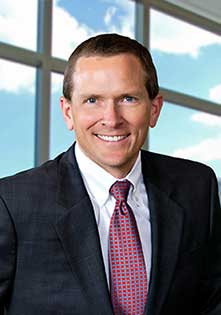How enlightening
During a cab ride in San Francisco an (energy-efficient) light bulb went on in the mind of Johnson Controls’ Kevin Self.
Out of the blue, Self’s cabdriver said he recently purchased a smart thermostat for his apartment. He liked being able to control his air-conditioning remotely, using an app on his cell phone. More importantly, the driver enjoyed paying less for his monthly utilities.
The conversation illuminated a bright future for the Michigan alum, who holds undergraduate and graduate degrees in engineering and bioengineering, respectively. As VP of strategy and corporate development at Johnson Controls’ building efficiency business, Self oversees a $14.6-billion operation. And he is on a mission to make “smart buildings” the norm and not the exception.
“Here’s a cabdriver making this decision regarding his small apartment,” he says. “So why are we not doing it for the millions of square feet of buildings that exist on this planet?”
Those buildings consume about 40 percent of all the energy we produce here on Earth, Self says. And that is a scenario that requires a dramatic shift in perspective — from the supply side of the energy equation to demand. The most sustainable strategy is not to produce increasing amounts of new energy, but to effectively monitor and manage the supply that already exists, he says. It’s about optimizing usage, reducing emissions, and avoiding energy costs. That’s where the smart technology comes in.
“The cheapest next power plant to develop is the one you don’t have to develop,” says Self, “because you’ve succeeded in reducing demand.”
So demanding
Self sees an energy-efficient sweet-spot on the horizon. He cites the convergence of a few significant trends in technology and consumer behavior: Today’s tech-savvy millennials have grown up using handheld computers. An increasing number of today’s most popular consumer products (from pedometers to major appliances) use smart technology. And consumers buying those products are well-versed in the ways of apps and analytics.
“Everyone has a smartphone; everything is being tracked,” Self says. “The built environment is yet another industry making use of big data. Now it’s a question of taking that data and understanding how to use it to serve a building’s needs at an actual point in time. It’s a different mindset than turning everything on at seven in the morning and everything off at six.”The key is to think about that building (and the buildings that surround it) as living, interconnected organisms with unique lifecycles and sets of operational needs, Self says.
Old buildings, new tricks
Milwaukee-based Johnson Controls Inc. recently retrofitted New York’s iconic Empire State Building. In just three years, the 80-year-old building has cut $7.5 million in energy costs. The savings exceed the firm’s initial projections, according to a report posted on the Johnson Controls website.
Last December the firm announced the biggest deal in its history, a comprehensive reboot of the 17 airports dotting the Hawaiian islands. The state’s energy costs are about triple those of its mainland counterparts. In the next 19 years, Johnson Controls guarantees that the Hawaii Dept. of Transportation will see $500 million in energy savings across the entire airport system.The Hawaii project addresses interconnected systems of heating, cooling, lighting, ventilation, and more. It will serve as a model for other multi-building initiatives, Self says.
“You might start by looking at a chiller in the basement; then you’re looking at the whole building, the whole block, the whole city.”
Johnson Controls also is working with the University of Akron to cut the energy consumed across its campus and reinvest those savings into university upgrades. Overall, the 15-year contract is projected to result in more than $58 million through streamlined operational and energy savings.
A change is gonna come
The ability to monitor and adjust real-time energy usage creates one stream of cost-savings. Preventative maintenance is another, Self says. In a world of extreme weather and extended power outages, it is essential to increase the number of resilient buildings capable of operating with fewer, better-managed resources.
If contingency planning doesn’t resonate with energy users, perhaps competition will. Utility companies often supply customers with data comparing their energy usage to neighbors. Competition can be a strong motivating factor – at both the consumer and commercial level – in upping efficiency and seeking cost savings.
But that takes time. Not surprising, change is slow to come in an industry with deeply entrenched infrastructure, so demonstrating return on investment in large, connected systems like airports and colleges may be the best way for Johnson Controls to build its “smart case” among civic and corporate decision-makers. Ideally, consumers experiencing small-scale benefits at home will become advocates for large-scale shifts in new and existing commercial construction projects.
“Maybe in the past people were motivated to [opt for sustainable solutions] because it was ‘doing good,'” Self says. “But most people are driven by dollars and cents. The goal is to demonstrate that making this change could be good for your pocketbook.
“In the end, it’s about reducing the energy demand necessary to sustain the planet going forward, which is a good thing for all of us.”
Self serves on the external advisory board of the U-M Energy Institute. He also serves on the board of directors for the bipartisan Alliance to Save Energy, a group designed to raise awareness at the municipal level. The alliance is spearheading the Energy 2030 campaign, with the intent to double energy productivity in the U.S. by 2030 and save $330 billion annually in avoided energy costs.
Watch a video interview with Self during “On the Road with Energy 2030,” which took place at U-M’s Erb Institute for Sustainable Enterprise earlier this year.





Victoria Neff - '74
Even if a person very much wants to be efficient with energy, it’s not easy (or even possible?) to get all the necessary data…………..
DTE twits me for being “less efficient” than my neighbors in re my usage of natural gas in the summertime.
I have a 1945 furnace, which runs a pilot all year ’round. I know the furnace is not as efficient as a newer furnace. On the other hand, it keeps on running.
How efficient can it be to buy a new furnace every 5-10 years? What is the energy cost of building a new furnace? What pollution is caused by that process? What habitat is trashed by the mining, etc, to get the materials to build new furnaces? What habitat is destroyed when land is taken for landfills for old furnaces? What pollutants eventually get into the water because old furnaces are in landfills? Whose livelihood is damaged by the pollution caused by all of these processes? Which wildlife is harmed? What is the environmental cost of shipping new and old furnaces hither and thither? Etc.?
The energy used by something *while in use* is far from being the only factor that determines what is “more efficient”…………
I don’t know how to get data on “other costs” when trying to be gentle on the planet, nor would I know how to factor that data into the overall cost of one behavior over another. I know darn well DTE doesn’t have this data, either, when it pretends to compare my energy use to my neighbors’ use…………..
Given that attempts to get me to “compete” with my neighbors on the topic of energy usage are based on only a tiny fraction of the relevant data, such attempts are offensive rather than motivating.
Reply